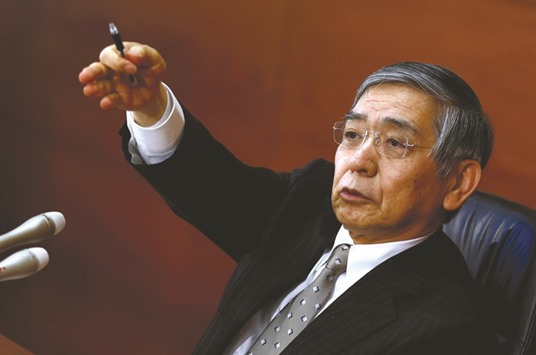The Bank of Japan shocked markets yesterday as it held fire on fresh stimulus measures, sparking questions about whether there is anything left in its policy arsenal to kickstart a sliding economy.
Dealers were caught off guard by the decision, which sent the yen skyrocketing, especially after another set of weak economic data in the morning had turned up the heat on policymakers to ignite stalling growth.
The BoJ also cut its GDP outlook and pushed back a timeline for its ambitious 2% inflation target – now expected before early 2018 rather than by September 2017.
The move underscored the challenges of conquering years of deflation that have weighed on growth.
The central bank’s consumer price target is a cornerstone of Tokyo’s broader drive to reignite the world’s number three economy.
“This is the last chance for BoJ governor Haruhiko Kuroda,” said Hideo Kumano, chief economist at Dai-ichi Life Research Institute.
“But the reality is that achieving the inflation target is going to be extremely difficult.”
Kuroda yesterday repeated that he “won’t hesitate” to pull the trigger on new stimulus, but said he wanted to see how a negative-rate policy announced in January was taking hold.
“I don’t think our ability to ease further has become limited,” Kuroda told reporters.
The rate move – which aims to encourage lending by essentially charging banks for storing some excess reserves in BoJ vaults – was widely panned as a desperate move to save Prime Minister Shinzo Abe’s faltering growth drive, dubbed Abenomics.
Markets had expected the BoJ would tinker with the new policy or expand its massive ¥80tn ($740bn) annual asset-buying plan.
The yen soared on the decision to stay put, with the dollar plunging to ¥108.31 in the afternoon, from ¥111.78 before the announcement.
Tokyo’s Nikkei stock index plunged more than 3%, with exporters hit by the yen surge.
“Markets now think the impact of any more BoJ easing measures is limited,” said Minori Uchida, head of Tokyo global markets research at Bank of Tokyo-Mitsubishi UFJ.
Official figures earlier yesterday showed consumer prices fell the most in three years.
The worse-than-expected fall – 0.3% in March from a year ago – came as separate data showed household spending remains weak, although factory output rebounded and the labour market was tight.
Japan’s economy has largely defied several years of central bank and government remedies aimed at boosting prices as well as broader activity.
Yesterday, the central bank pointed to weakness in overseas markets and the impact of deadly earthquakes in southern Japan this month, which led to factory shutdowns, for scaling back its economic growth projections.
The economy shrank 0.3% in the last quarter of 2015 and there are concerns that the January-March GDP data will also come in weak.
Abe swept to power more than three years ago vowing to revive the country’s fortunes with a mix of policies centred on central bank monetary easing, targeted government spending and deregulation.
But his attempts to power inflation has been hit by falling energy prices, coupled with recent robustness in the yen driving down the cost of imports.
This month, the International Monetary Fund this month cut its growth forecast for the country, saying GDP would shrink next year as a planned sales tax rise tightens consumer spending.
It also warned that deflation – a persistent and debilitating decline in prices – could return to Japan.
Japan probably narrowly escaped recession in the first quarter but weak domestic and external demand and a strong yen will keep a lid on any recovery, a Reuters poll showed.
Gross domestic product (GDP) likely expanded at an annualised 0.6% in January-March, the median forecast of 12 analysts showed, after the world’s third-largest economy contracted in the fourth quarter of 2015, hurt by weak private consumption and housing investment.
But many analysts said even that meagre growth level is largely due to having an extra Leap Year day in the quarter, and believe economic growth was likely around zero or even contracted slightly if adjusted for that factor.
“The overall economic elements are not good, especially consumer spending has been crawling to the bottom after a sales tax hike (in April 2014),” said Yoshiki Shinke, chief economist at Dai-ichi Research Institute.
“The outlook for capital spending is uncertain amid worries about corporate earnings, overseas demand is weak and the yen remains strong. So there are no economic factors to help the growth.”
Three of the 12 analysts surveyed believed the economy shrank in the first quarter, which would mean a second straight quarter of contraction – the definition of a technical recession – after a 1.1% decline in the final quarter last year.
On a quarter-on-quarter basis, GDP was expected to grow 0.1% in the first quarter after a 0.3% contraction in October-December 2015.
Private consumption, which accounts for roughly 60% of GDP, was expected to show a quarterly gain of 0.2% following a 0.9% slide in the previous quarter.
The poll found capital spending declined 0.8% after rising 1.5% and an external demand likely contributed 0.1% point to GDP growth.
The government will announce GDP for the first quarter on May 18.

Bank of Japan governor Haruhiko Kuroda gestures during a news conference in Tokyo. The BoJ shocked markets yesterday as it held fire on fresh stimulus measures, sparking questions about whether there is anything left in its policy arsenal to kickstart a sliding economy.


